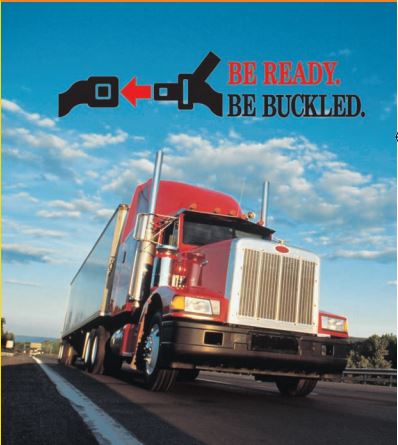The Federal Motor Carrier Safety Administration (FMCSA) within the U.S. Department of Transportation regulates the interstate – and, to a certain degree and under certain conditions, intrastate – transportation by highway of persons and property by a Commercial Motor Vehicle.
If you operate a CMV, the FMCSA wants you to do so safely and in compliance with the Federal Motor Carrier Safety Regulations (FMCSR) which require the driver of a CMV to wear a safety belt.
The purpose of this article is to identify and dispel nine myths related to safety belt use in CMVs.
MYTH 1: Safety belts are uncomfortable and restrict movement.
FACT:
Most drivers find that once they correctly adjust the seat, lap and shoulder belt, most drivers find that discomfort and restrictive movement can be alleviated.
MYTH 2: Wearing a safety belt is a personal decision that doesn’t affect anyone else.
FACT:
Not wearing a safety belt can certainly affect your family and loved ones. It can also affect other motorists since wearing a safety belt can help you avoid losing control of your truck in a crash. It’s the law; Federal regulations require commercial vehicle drivers to buckle up.
MYTH 3: Safety belts prevent your escape from a burning or submerged vehicle.
FACT:
Safety belts can keep you from being knocked unconscious, improving your chances of escape. Fire or submersion occurs in less than 5% of fatal large truck crashes.
MYTH 4: It’s better to be thrown clear of the wreckage in the event of a crash.
FACT:
An occupant of a vehicle is four times as likely to be fatally injured when thrown from the vehicle. In 2006, 217 truck occupants and drivers died when they were ejected from their cabs during a crash.
Contact me with any questions you may have about the transportation of hazardous materials by air, highway, vessel, or rail International and Domestic Daniels Training Services 815.821.1550 |
MYTH 5: It takes too much time to fasten your safety belt 20 times a day.
FACT:
Buckling up takes about three seconds. Even buckling up 20 times a day requires only one minute.
MYTH 6: Good truck drivers don’t need to wear safety belts.
FACT:
Good drivers usually don’t cause collisions, but it’s possible that during your career you will be involved in a crash caused by a bad driver, bad weather, mechanical failure, or tire blowout. Wearing a safety belt prevents injuries and fatalities by preventing ejection, and by protecting your head and spinal cord.
MYTH 7: A large truck will protect you. Safety belts are unnecessary.
FACT:
In 2006, 805 drivers and occupants of large trucks died in truck crashes and 393 of them were not wearing safety belts. Of the 217 drivers and occupants who were killed and ejected from their vehicles, almost 81% were not wearing safety belts.
MYTH 8: Safety belts aren’t necessary for low-speed driving.
FACT:
In a frontal collision occurring at 30 mph, an unbelted person continues to move forward at 30 mph causing him/her to hit the windshield at about 30 mph. This is the same velocity a person falling from the top of a three story building would experience upon impact with the ground.
MYTH 9: A lap belt offers sufficient protection.
FACT:
The lap and shoulder belt design has been proven to hold a driver securely behind the wheel in the event of a crash, greatly increasing the driver’s ability to maintain control of the vehicle and minimizing the chance for serious injury or death.
More Facts to Consider:
- In 2006, 703 drivers of large trucks died in truck crashes and 314 of those drivers were not wearing safety belts. Of the 188 drivers killed who were ejected from their vehicles, almost 80% were not wearing safety belts.
- In 2006, 805 drivers and occupants of large trucks died in truck crashes and 393 of these were not wearing safety belts. Of the 217 drivers and occupants who were killed and ejected from their vehicles, approximately 81% were not wearing safety belts.
- Federal Motor Carrier Safety Regulations require commercial motor vehicle drivers to wear safety belts. (49 CFR 392.16)
- 52% of truck-occupant-fatalities in large trucks involve a rollover. Rollover in a large truck increases the likelihood of fatality by 30 times. In a rollover, a truck driver is 80% less likely to die when wearing a safety belt.
- About 23,000 large truck occupants suffered nonfatal injuries in crashes; of these, 4,000 were seriously injured.
If you’re the driver of a Commercial Motor Vehicle (or any vehicle for that matter), you should take the Safety Belt Pledge:
I will wear my safety belt because my well-being greatly affects my family and loved ones. It is my responsibility to maintain control of my vehicle. Using my safety belt is my best chance of remaining in control of my truck in a crash or emergency situation. I will always remember to buckle up.
X __________________________________
Driver Signature
If you transport any amount of a hazardous material you will also be subject to the regulations of a different administration within the USDOT: the Pipeline and Hazardous Materials Safety Administration or PHMSA. PHMSA will require you to comply with the Hazardous Material Regulations and to be trained as a HazMat Employee with an additional component of Driver Training.

